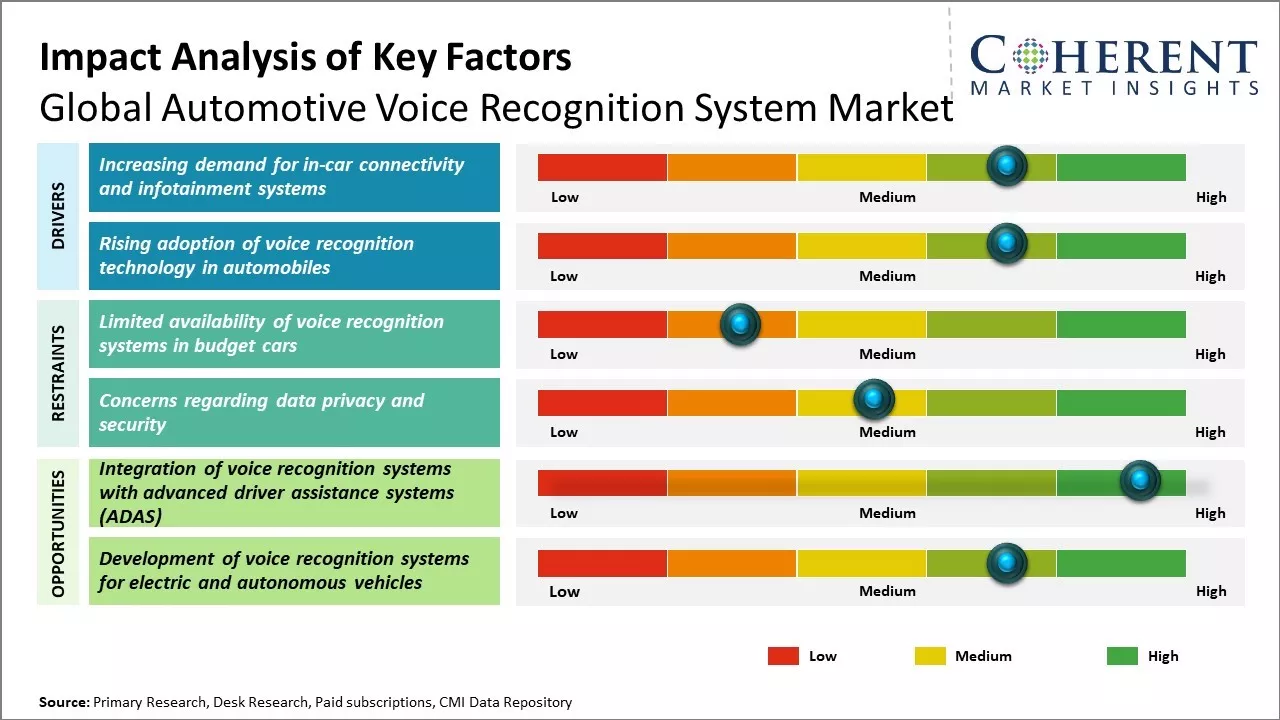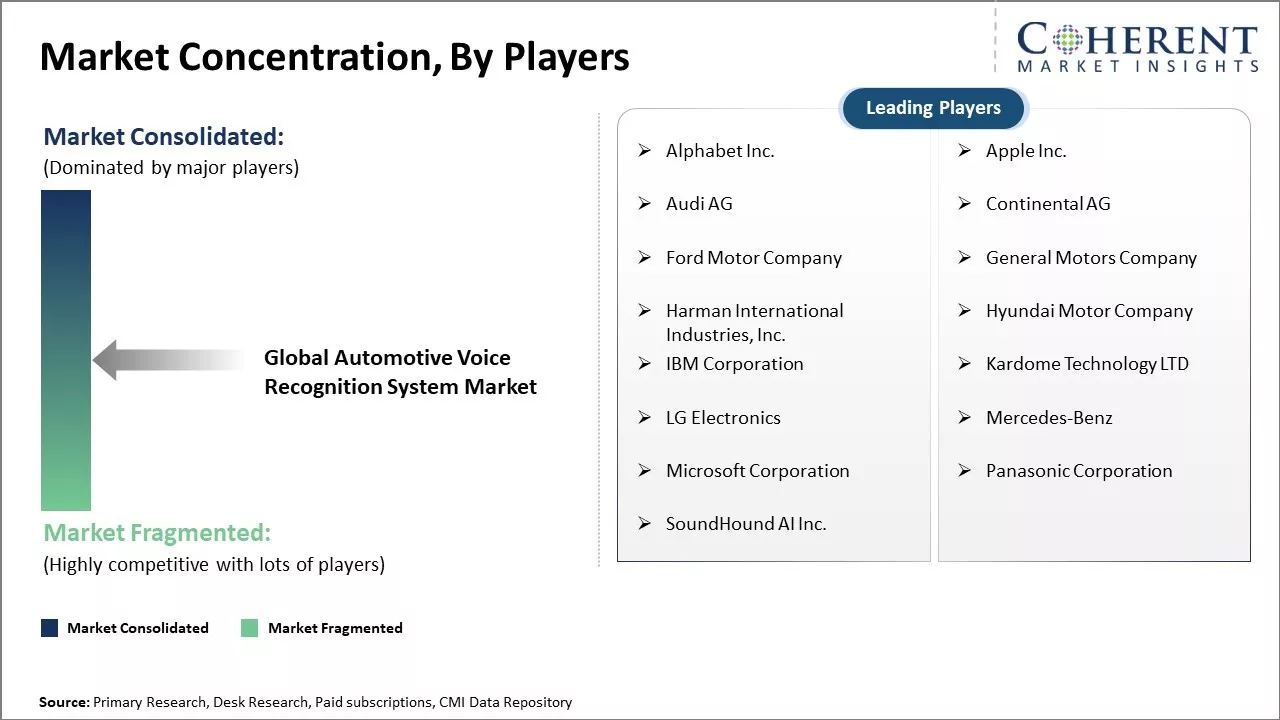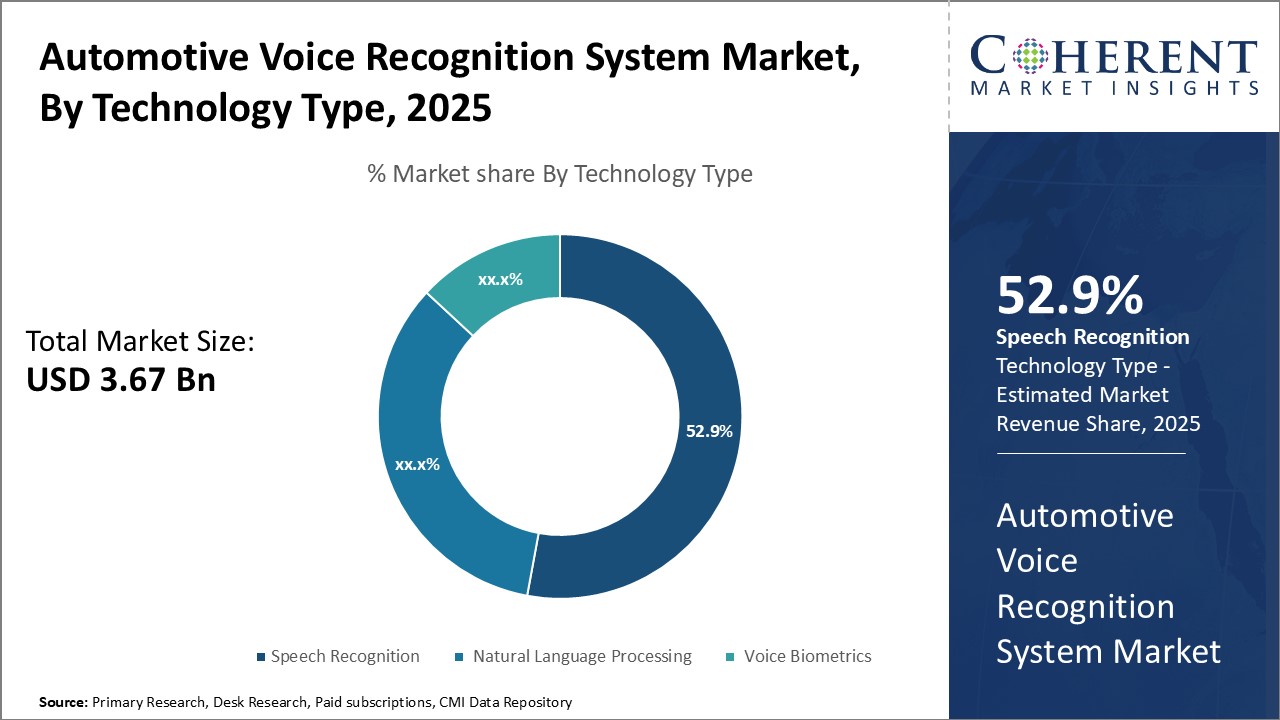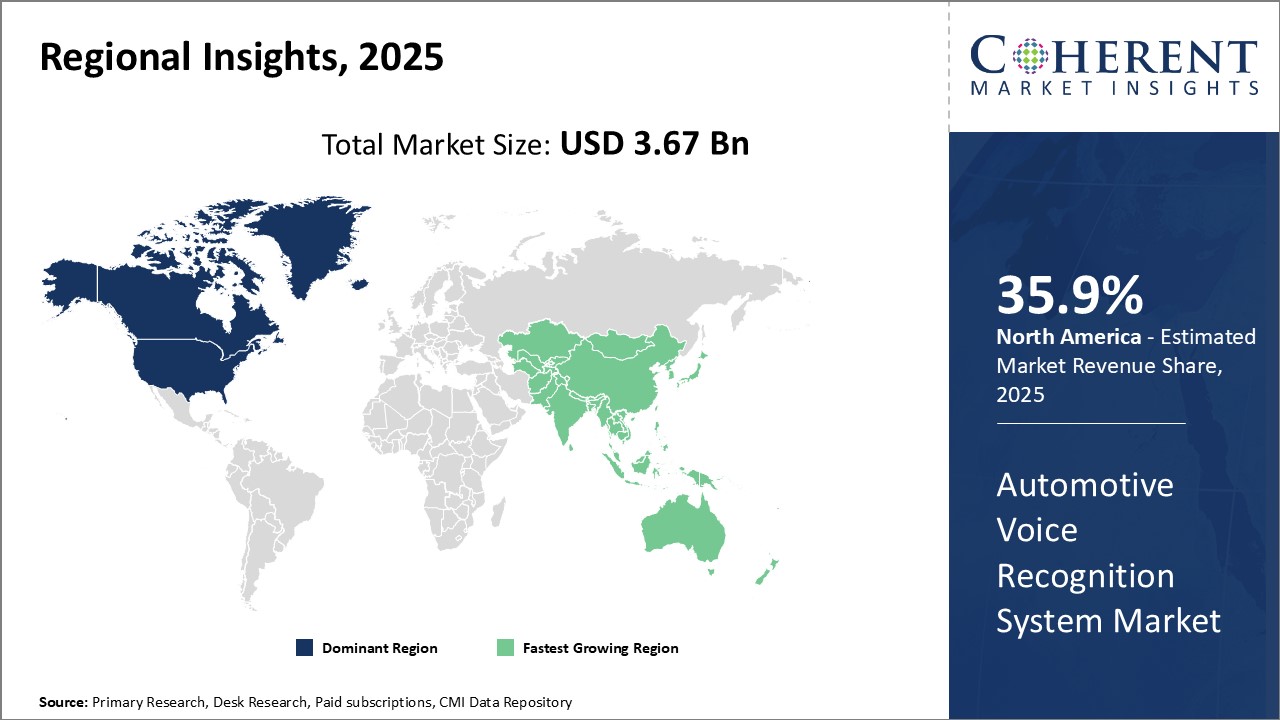Automotive Voice Recognition System Market Size and Trends
Global automotive voice recognition system market is estimated to be valued at USD 3.67 Bn in 2025 and is expected to reach USD 10.01 Bn by 2032, exhibiting a compound annual growth rate (CAGR) of 15.4% from 2025 to 2032.

Discover market dynamics shaping the industry: Download Free Sample
Rising adoption of connected vehicles and growing demand for enhanced safety and convenience features in cars can boost demand for automotive voice recognition system. The automotive voice recognition system market is expected to experience strong growth over the forecast period. Driven by increasing technological advancements to improve voice recognition accuracy through artificial intelligence and need to offer seamless connectivity experience for occupants, major automotive companies are increasingly integrating voice assistants in newer car models. Market players are focused on developing more natural and personalized voice systems to stay ahead of competition.
Increasing demand for in-car connectivity and infotainment systems
The automotive industry has witnessed tremendous changes in recent years, owing to growing consumer inclination towards an enhanced driving experience. Vehicle owners not only want a mode of transportation but an extension of their smart devices and digital lifestyle in their cars. In-car connectivity through built-in infotainment systems has emerged as a key differentiator for automakers looking to attract new buyers. Features such as navigation, voice commands, smart mobile integration through Apple CarPlay and Android Auto as well as access to various in-cabin controls are becoming must-haves for customers.
This rising demand stems from the digital habits of modern consumers who have grown accustomed to being constantly connected through their smartphones and other smart devices. Long commutes in traffic-filled cities have further amplified the need for in-vehicle entertainment and productivity options. Drivers want the ability to make calls, listen to music, get directions and traffic updates, check news or emails and stream content seamlessly within their cars without having to shift focus from the road. For passengers as well, being able to access their favorite apps and content keeps them engaged during trips.
Advanced connectivity solutions require intuitive user interfaces for optimal user experience. Voice assistants have transformed how drivers and passengers can control their infotainment systems in a way that maintains safety. Automotive manufacturers are busy integrating advanced speech recognition capabilities to support an ever-growing range of commands related to multimedia playback, navigation, telephony features and vehicle parameters. This allows occupants to stay focused on driving or relaxing without manual distractions.
Market Concentration and Competitive Landscape

Get actionable strategies to beat competition: Download Free Sample
Rising adoption of voice recognition technology in automobiles
Beyond infotainment and connectivity, voice recognition is used across different components and systems within modern vehicles. Automakers have been developing advanced driver-assistance systems such as adaptive cruise control, lane-keep assist and self-parking abilities to enhance safety and convenience. Voice assistants can effectively work in tandem with these technologies for remote activation and adjustment of functions through natural commands. This reduces manual actions required by the driver and allows them to keep both hands on the wheel in assisted driving modes. Passengers can also benefit from mobility features tailored to their needs using just their voice.
As vehicles take over more driving tasks, occupants may spend less time paying attention to the road. In such situations, voice interfaces can play a critical role in keeping drivers engaged as supervisors through multifunctional dashboards and heads-up displays controlled by speech. Furthermore, conversations with AI assistants help identify driver alertness or distraction, a key safety parameter for self-driving cars. Voice recognition enables more natural human-vehicle communication for maintenance of driver readiness along autonomous drives.
Automakers are focusing on advanced applications of speech recognition beyond connectivity. In-car voice assistants can gain enhanced cognition to fulfil contextual information needs, execute complex multistep tasks and monitor cabin conditions & driver state through conversational interactions. This drives voice recognition as a core transforming technology in the automotive space.
For instance, In April 2023, Cerence Inc., a leading provider of AI-powered voice and conversational technology for the automotive industry, announced that Chinese smart car supplier- Banma had selected Cerence to integrate advanced in-car conversational AI and voice recognition technology for Banma’s automaker clients, including Shanghai Volkswagen Automotive Co. (SVW) and FAW-Volkswagen (FAW-VW). Cerence’s flagship conversational AI enables in-car assistants to act as proactive, trusted co-pilots, guiding drivers through their daily journeys while ensuring safety, information access, and comfort. This partnership aims to enhance the in-car experience by leveraging Cerence's innovative technologies.
Key Takeaways from Analyst:
Global automotive voice recognition system market growth is driven by rising demand for convenience features in vehicles and increasing digitization of automotive technologies as most major automakers are actively incorporating voice controls into their vehicles. However, connectivity issues and lack of consistent internet access could hamper the ability of these systems to function optimally. As 5G connectivity proliferates, it can help overcome these restraints.
The market will continue to be dominated by luxury and premium vehicles, as these segments were the early adopters of this technology. However, as costs come down, mass market automakers will also integrate voice recognition as a standard feature across their model lines. North America remain at the forefront of adoption for automotive voice recognition system driven by tech-savvy consumers in the region. Meanwhile, Asia Pacific is expected to emerge as the fastest growing regional market.
As automakers work on improving accuracy and expanding command functionalities, there will be growth in consumer acceptance of this technology. Technological advancement such as integration with AI digital assistants can make interaction even more natural and intuitive.
Market Challenge - Limited availability of voice recognition systems in budget cars
As automotive voice recognition system market is still in a nascent stage of growth, major providers are focusing their efforts on high-end and luxury vehicles where the return on investment is higher. Budget car manufacturers have been slow to integrate these systems into their affordable models due to the additional costs involved. Voice recognition technology requires advanced processors and cloud-based capabilities for deep learning and natural language processing. For price-sensitive customers, adding to the production costs can impact demand. With limited consumer awareness about the benefits, the appeal is currently higher among early adopters with more disposable income. Unless costs come down significantly or benefits are clearly demonstrated, broader proliferation into small and budget car segments can remain restricted.
Opportunity: Integration of voice recognition systems with advanced driver assistance systems (ADAS)
As autonomous driving technologies evolve through successive SAE levels, advanced driver assistance systems (ADAS) are becoming increasingly common on passenger vehicles. Features like adaptive cruise control, lane keeping assist and automated emergency braking aim to simultaneously improve safety and comfort for drivers. Integrating voice recognition capabilities with ADAS opens up new use cases for in-vehicle control and monitoring of such functions. Drivers may be able to seamlessly activate, adjust or disable autonomous modes through simple voice commands instead of manual screen options or button presses. Automakers stand to gain by offering enhanced ‘hands-free’ and ‘eyes-free’ ADAS features, which could help expand the potential market for such systems beyond luxury vehicles. Partnerships between voice technology and automotive electronics companies are likely to differentiate offerings and accelerate adoption across more affordable models.

Discover high revenue pocket segments and roadmap to it: Download Free Sample
By Technology Type - Speech Recognition Segment Dominated Due To Rise Of Conversational Interfaces
In terms of technology type, speech recognition segment is estimated to contribute the highest market share of 52.9% in 2025, owing to its natural and user-friendly interface. Speech recognition technology allows drivers to control vehicle functions and access information simply by speaking instead of manually operating buttons or touchscreens. This hands-free interaction creates a more seamless in-car experience and increases safety by keeping drivers' eyes on the road and hands on the wheel. Comprehensive speech recognition systems can understand complete sentences and questions, responding to a wide variety of commands to adjust climate, media, navigation and other settings.
Growing desire among automakers and consumers for intuitive, conversational in-car interfaces can drive the segment growth. Younger drivers have grown up interacting with voice assistants on their smartphones and expect a similar interface in the vehicle. Speech also transcends language barriers more easily than other input methods, opening the technology to a broader global customer base. Rising demand for always-on assistants like Alexa, Siri and Google has improved the capabilities of speech recognition algorithms through increased training. Automakers are now able to deploy more accurate and complex speech systems in vehicles to create a natural conversational experience.
Rising autonomous driving further underscores the importance of speech interfaces. As vehicles take over more active driving functions, speech recognition will become the primary way occupants control the vehicle and access information services. This will elevate the user experience beyond basic commands to more natural dialogues. With further advancements, speech systems could understand drivers' complete intent through contextual conversations. As interactions with technology become increasingly conversational, speech recognition is firmly positioned to take the leading interface role in vehicles.
By Vehicle Type - Passenger Cars Segment Drive the Market Due To Focus On Consumer Technology Features
In terms of vehicle type, passenger cars segment is estimated to contribute the highest market share of 66.8% in 2025, due to their focus on consumer technology features. Voice recognition systems in passenger vehicles go beyond utility to enhance the in-cabin experience through connected conveniences. Unlike commercial vehicles where functions center around navigation and fleet management, automakers are developing speech technology for passenger cars that emphasize entertainment, communication and personalization.
In-vehicle infotainment can boost adoption of voice system in passenger cars. Advanced systems integrate with cloud-based apps and services for music, news, audiobooks and more. Passengers can search content playlists, start and pause media, get recommendations and adjust settings using only voice commands. Connected features keep rear passengers engaged on longer journeys. In-car communication capabilities let drivers and passengers interact with smart assistants to send messages, get directions read aloud or place hands-free calls.
Over-the-air updates expand functionality of installed systems, addressing customer demand for the latest connected features. Wireless connectivity and embedded personal devices further enrich in-car experience through seamless integration of consumers' digital lives into the vehicle. As passenger cars adopt more advanced infotainment and connectivity, voice interfaces enhance usability and promote adoption of new in-cabin technologies.
By Application - Infotainment Systems Segment Leading the Market Due to Optimizing Workflow in Commercial Vehicles
In terms of application, infotainment systems segment is estimated to contribute the highest market share of 44.3% in 2025. For fleet management, voice commands allow drivers to remotely access dispatch instructions, logistics updates, document reading and recording vocally without manual distraction. Real-time navigation routing keeps fleets on schedule with less time spent looking at screens. Climate settings optimized for cargo also help ensure on-time deliveries of temperature-sensitive shipments. Two-way communication systems bolster roadside assistance and emergency response.
In buses and trucks, voice activates destination signs, automated announcements and passenger intercom without manual button pressing by the driver. Tactile or virtual switches integrated with steering wheels let commercial operators seamlessly control operations through speech. Construction and agricultural equipment customize voice profiles to navigate digital work orders, monitor telemetry and accomplish tasks more productive hands-free.
As commercial vehicles upgrade to connected technologies, voice streamlines complex in-vehicle processes for enhanced safety, efficiency and workflow management. Its advantages can boost innovations optimizing back-office integration in shared mobility and logistics operations through intuitive spoken commands.
Regional Insights

Need a Different Region or Segment? Download Free Sample
North America dominates the global automotive voice recognition system market with an estimated market share of 35.9% in 2025. The large-scale presence of major automakers like General Motors, Ford and Tesla has ensured early adoption of the latest technologies in this region. Strong investment in R&D by these companies to integrate more advanced features in their vehicles boosts the automotive voice recognition system market in North America. Moreover, high consumer spending power and preference for luxury and technologically advanced vehicles further support the growth of new automotive technologies. With majority of global tech giants based in the U.S., there is significant innovation in the field of voice recognition and natural language processing. Automakers leverage these developments to enhance the voice command capabilities in their cars.
Trend of connected vehicles also drives the market growth. Modern vehicles are increasingly becoming internet-enabled with connectivity and infotainment becoming a priority for drivers. Voice recognition systems allow for seamless control of these connected features via voice commands, acting as a differentiating factor. The competitive automotive industry and preference for latest in-car experience have made North America the innovation hub for automotive voice recognition technologies.
Asia Pacific region has emerged as the fastest growing market for automotive voice recognition system. Rapid motorization in major countries like China and India boosts the automotive industry growth in Asia. Local automakers are expanding their product lineups with more sophisticated and technology-focused models to cater to rising middle-class. Voice recognition is seen as an aspirational feature for these new vehicle buyers. Foreign automakers are setting up local manufacturing facilities in Asia to gain access to these high growth markets. This has accelerated technology transfer and adoption of advanced driver assists including voice recognition systems.
Evolving regulatory frameworks promoting connected mobility are also encouraging automakers to equip their Asian fleet with voice command options for safe driving.
Market Report Scope
Automotive Voice Recognition System Market Report Coverage
| Report Coverage | Details | ||
|---|---|---|---|
| Base Year: | 2024 | Market Size in 2025: | USD 3.67 Bn |
| Historical Data for: | 2020 To 2024 | Forecast Period: | 2025 To 2032 |
| Forecast Period 2025 to 2032 CAGR: | 15.4% | 2032 Value Projection: | USD 10.01 Bn |
| Geographies covered: |
|
||
| Segments covered: |
|
||
| Companies covered: |
Alphabet Inc., Apple Inc., Audi AG, Continental AG, Ford Motor Company, General Motors Company, Harman International Industries, Inc., Hyundai Motor Company, IBM Corporation, Kardome Technology LTD, LG Electronics, Mercedes-Benz, Microsoft Corporation, Panasonic Corporation, SoundHound AI Inc. |
||
| Growth Drivers: |
|
||
| Restraints & Challenges: |
|
||
Uncover macros and micros vetted on 75+ parameters: Get instant access to report
Automotive Voice Recognition System Industry News
- In January 2024, Volkswagen AG, a leading global automotive manufacturer, announced that Cerence Chat Pro systems integrated into the infotainment systems of the VW ID.3, ID.4, ID.5, ID.7, Tiguan, Passat, and Golf models would feature ChatGPT integration. This collaboration with Cerence Inc., a pioneer in automotive voice AI technology, aims to enhance the voice assistant capabilities of these vehicles. By leveraging ChatGPT's natural language processing and knowledge base, the Cerence Chat Pro system will assist with parsing voice requests and enabling a variety of functions, including controlling the infotainment system, navigation, and climate controls. This integration underscores Volkswagen's commitment to providing innovative and user-friendly technologies to its customers.
- In November 2023, Renault Korea Motors, a subsidiary of the Renault Group focused on the Korean automotive market, announced that it had signed a memorandum of understanding (MOU) with Tmap Mobility Co., a leading provider of digital mobility solutions in South Korea. This collaboration aims to enhance infotainment systems as part of the "Aurora Project," a new car development initiative. Renault Korea plans to equip its upcoming mid-size hybrid sports utility vehicle (SUV) with "Tmap Infotainment," which will offer features such as in-car voice recognition through "NUGU Auto," Tmap Store, in-car easy payment options, and specialized services for electric vehicles.
- In August 2023, SoundHound AI Inc., a leading innovator in voice artificial intelligence, launched its advanced AI technology, featuring innovative Edge+Cloud connectivity, multilingual capabilities, and a custom-branded voice assistant. This technology is set to be integrated into a new line of smart vehicles from Turkish mobility provider Togg. The in-vehicle AI-powered voice assistant can track and understand speech context in real-time, even anticipating user queries before they finish speaking. Utilizing SoundHound’s proprietary Speech-to-Meaning® and Deep Meaning Understanding technologies, the assistant can address multiple questions and filter results, significantly enhancing the user experience in smart vehicles.
- In September 2022, BMW Group selected Cerence Inc., a leading automotive voice and AI technology provider, to develop a new voice-powered assistant for the latest version of the BMW Intelligent Personal Assistant (IPA). This advanced voice assistant is set to be integrated into the new BMW 7 Series and BMW i7 models, enhancing the driving experience with improved natural language understanding and context-aware responses. Cerence's technology will allow drivers to interact with their vehicles more intuitively, making commands easier and more flexible.
*Definition: Global automotive voice recognition system market involves voice recognition systems installed in vehicles to allow drivers and passengers to control certain vehicle functions and features using voice commands. These systems allow hands-free access to music, navigation, phone calls and other infotainment functions through simple voice commands. The growing demand for convenience and safety in vehicles is driving the growth of this market globally. Major automakers are focusing on integrating advanced voice recognition technologies.
Market Segmentation
- By Technology Type Insights (Revenue, USD Bn, 2020 - 2032)
- Speech Recognition
- Natural Language Processing (NLP)
- Voice Biometrics
- By Vehicle Type Insights (Revenue, USD Bn, 2020 - 2032)
- Passenger Cars
- Commercial Vehicles
- Electric Vehicles (EVs)
- By Application Insights (Revenue, USD Bn, 2020 - 2032)
- Infotainment Systems
- In-Car Navigation
- Climate Control Systems
- Communication Systems
- By Regional Insights (Revenue, USD Bn, 2020 - 2032)
- North America
- U.S.
- Canada
- Latin America
- Brazil
- Argentina
- Mexico
- Rest of Latin America
- Europe
- Germany
- U.K.
- Spain
- France
- Italy
- Russia
- Rest of Europe
- Asia Pacific
- China
- India
- Japan
- Australia
- South Korea
- ASEAN
- Rest of Asia Pacific
- Middle East
- GCC Countries
- Israel
- Rest of Middle East
- Africa
- South Africa
- North Africa
- Central Africa
- North America
- Key Players Insights
- Alphabet Inc.
- Apple Inc.
- Audi AG
- Continental AG
- Ford Motor Company
- General Motors Company
- Harman International Industries, Inc.
- Hyundai Motor Company
- IBM Corporation
- Kardome Technology LTD
- LG Electronics
- Mercedes-Benz
- Microsoft Corporation
- Panasonic Corporation
- SoundHound AI Inc.
Share
Share
About Author
Gautam Mahajan is a Research Consultant with 5+ years of experience in market research and consulting. He excels in analyzing market engineering, market trends, competitive landscapes, and technological developments. He specializes in both primary and secondary research, as well as strategic consulting across diverse sectors.
Missing comfort of reading report in your local language? Find your preferred language :
Transform your Strategy with Exclusive Trending Reports :
Frequently Asked Questions
EXISTING CLIENTELE
Joining thousands of companies around the world committed to making the Excellent Business Solutions.
View All Our Clients
